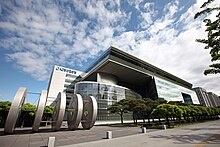Bank of Korea
The Korean War began only thirteen days after the bank was created, forcing the Head Office to relocate to Daejon, Daegu and Busan.
To stop a liquidity crisis during the war, the bank instituted a limit on withdrawals of ₩10,000 per week and ₩30,000 per month for households.
The bank repaid $470 million in aid from the UN Korean Reconstruction Agency and Economic Cooperation Administration beginning in 1952.
After the Korean War, inflation remained high with a 48 percent annual increase in wholesale prices in Seoul from 1954 to 1956.
The Bank of Korea underwrote and absorbed five billion hwan of Industrial Rehabilitation Bonds to finance the KDB.
South Korea had bumper rice harvests and grain prices dropped with surplus agricultural products from the US.
When the Democratic Party took power in 1960 after the April 19 Revolution, they pursued fiscal austerity and ended up with significant financial surpluses.
On November 1, the government added Monetary Stabilization Bonds with no holding limits on risk-weighted assets and credit ceilings.
Through 1963, a poor harvest, declining US aid and depletion of foreign currency reserves to pay for imports steeply devalued the won.
In November 1969, the government tried to "cool off" the economy which had grown at over 10 percent annually, but had soaring prices and current account deficits, by imposing lending and rediscount ceilings.
Between 1974 and 1976 it created the National Investment Fund and the Export-Import Bank of Korea to finance chemical and heavy industry.
Between 1982 and 1983, non-bank financial institutions such as mutual savings, an investment trust company and short-term financing groups were allowed to open up.
Foreigners were allowed partial equity stakes in domestic companies after August, 1989 and banks exchange rates were liberalized a month later under pressure from the US to let the won appreciate.
Market liquidity dried up as banks refused to lend and major Korean firms such as the Hanbo Group declared bankruptcy.
The Bank of Korea purchased two trillion won of bonds in the Non-Performing Asset Resolution Fund to restructure financial institutions.
[6] Deregulation of credit cards led to significant lending after 1999 and a high delinquency ratio, which kicked off a financial crisis when an accounting scandal was revealed at SK Global on March 11, 2003.
The Bank of Korea launched a short-term liquidity of two trillion won in repurchase agreements to prevent the crisis from spreading.
As for its executive body in detail, The Bank has 15 departments in its head office in Seoul, and 16 branches in major cities.
In addition, it has five overseas representative offices in major international financial centers, such as New York, Frankfurt, Tokyo, London, Beijing.
The Auditor, appointed by the President on the recommendation of the Minister of Strategy and Finance, inspects the operations of the Bank of Korea and reports the results to the Monetary Policy Committee.
The Auditor prepares and submits a comprehensive audit report to the government and Monetary Policy Committee each year.
The banknotes and coins thus issued have the status of legal tender within the country for all transactions, both public and private, without limitation.
This is a process of controlling the supply or cost of money in order that the economy may grow in a sound manner on the basis of price stability.
The Bank operated a real-time gross settlement system for large-value interbank fund transfers, named BOK-Wire, since mid-December 1994.
It also publishes various periodicals, such as the Annual Report and the Monthly and Quarterly Bulletins, to provide accurate and up-to-date information on the economy to the public.
The Bank, however, does occasionally conduct smoothing operations in concert with the government in order to moderate disorderly movements prompted by herd behavior and the like.
The Bank invests the reserves mainly in safe and liquid foreign financial assets and strives to improve their profitability insofar as this does not detract from their safety.
The Bank also holds international seminars and workshops to share the nation's experience in having achieved remarkable economic development and overcoming financial crises.




